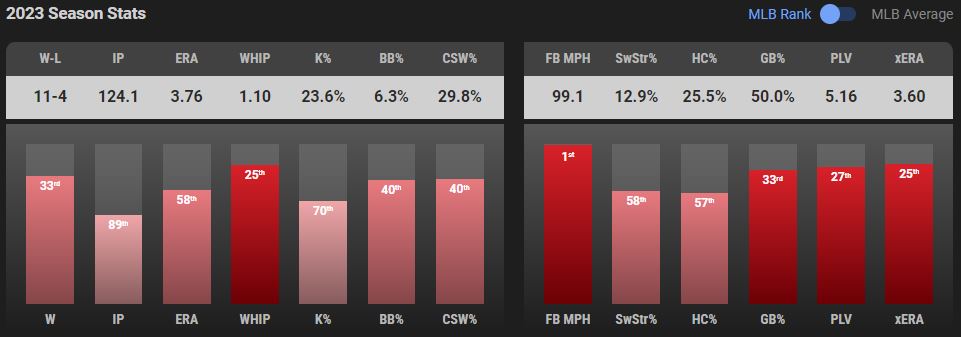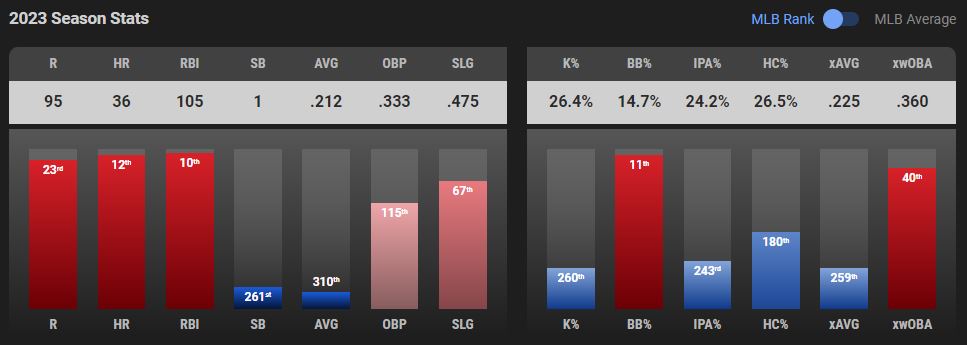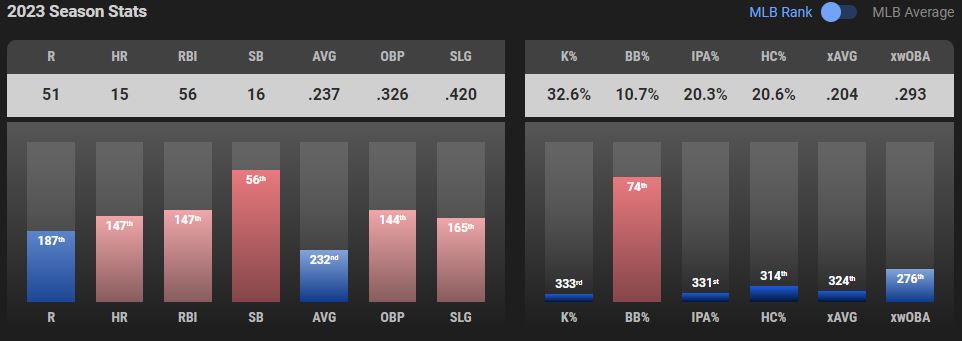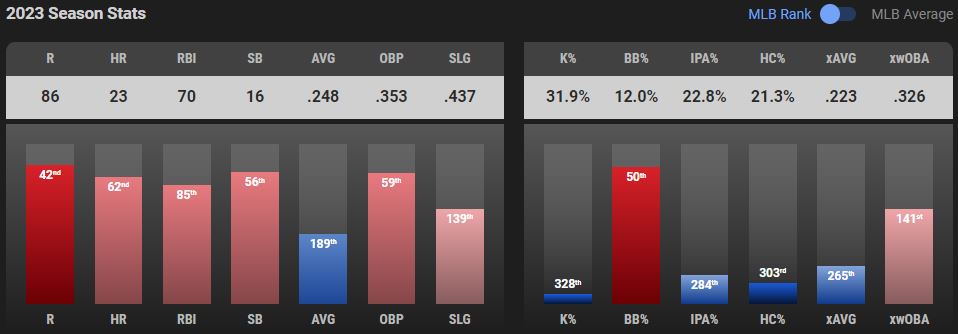The Dodgers have made some news this offseason, to say the least. In winning the Shohei Ohtani sweepstakes, the front office has revolutionized — whether for good or ill is to be determined — how contracts can be structured by deferring the overwhelming bulk of his salary to 2033 and beyond. The move has shaken the baseball world and will have significant repercussions for years to come, at least until the next Collective Bargaining Agreement.
Since he won’t be pitching in 2024, Ohtani’s impact on the team will likely be at its smallest this season compared to the rest of his contract. Ohtani the hitter will replace JD Martinez in the lineup, which given the season Martinez had last year (.271 AVG, 33 HR, 103 RBI) is still an upgrade, but probably not as big of one as you might think. Manager Dave Roberts might bat Ohtani second, but given how he often prefers to alternate lefty and righty hitters, he could slot the prized acquisition in the cleanup spot after Betts (RHB), Freeman (LHB), and Will Smith (RHB).
Regardless of where Ohtani hits, the top half of the Dodgers’ lineup will be the best in baseball. But the lower half still falls off quite a bit — in 2023 some of their younger talent didn’t quite pan out or had inconsistent seasons, and a few of the veterans showed their age. The Dodgers still won 100 games, but that was 11 fewer than in 2022, and getting swept by the Diamondbacks exposed their weaknesses.
The Dodgers are smarting from that early playoff ejection, which also showed major holes in their rotation. They’ve addressed this as well by trading a promising young hurler in Ryan Pepiot for Tampa ace Tyler Glasnow, who when healthy is as good as any pitcher in baseball. They will also welcome back Walker Buehler from his second Tommy John and made another huge free agency splash in signing Japanese sensation Yoshinobu Yamamoto.
As for the lineup depth…it’s still only January, so time will tell. Miguel Vargas was everyone’s sleeper last winter but never found consistency after a preseason thumb injury, and the Dodgers shifted Mookie to second base to make Vargas a bench player. This year’s lineup will again feature Jason Heyward, James Outman, and Chris Taylor in the outfield, now rotating with Manuel Margot (who comes over as part of the Glasnow deal). And the jury’s still out on Gavin Lux, who will play every day at shortstop and likely bat ninth after missing all of last season with a knee injury.
All told, the Dodgers have spent over a billion dollars this winter, including two of the largest contracts ever, and have two key players returning from long injuries. They’re hoping to create a dynasty in LA that could rival any in baseball history, along with dominating the lucrative Asian marketplace with their Japanese superstars. Whether it all works out will take years to determine, but expectations will be sky-high for a title this season and beyond.
Sleepers
Not many Dodgers will go under the radar, but here are a couple of players who we think will outperform their fantasy draft position:
2023 Stats (124.1 IP): 3.76 ERA, 1.10 WHIP, 102 K, 7 W
Miller was first drafted in the 38th round out of High School by the Orioles in 2017 but declined to play in college. It was a smart move — after a few standout seasons at Louisville, he moved up 37 rounds to be the 29th overall pick by the Dodgers in 2020.
Miller quickly moved up the prospect ranks to profile as LA’s top pitcher in the Minors, even with Pepiot and Gavin Stone also having lofty profiles. A few injuries to the rotation in May — all too common with the Dodgers last year — forced the team to move Miller to the Bigs on an accelerated schedule. They likely had plans to send him back but his performance made them think otherwise, and he went on to start 22 more games with the club.

Bobby Miller is good at everything
A bit of a throwback with a 5-pitch arsenal — each pitch being used at least 15% of the time — Miller can keep hitters guessing anywhere in the count. However, some of his pitches showed better results than others. About halfway through the season Miller made an adjustment and started throwing his slider less and his curveball more, which appeared to pay off given the splits between the two offerings:
| Pitch | Usage | BA | CSW% | GB% | BABIP |
| Slider | 17.4% | .260 | 26.1% | 47.1% | .338 |
| Curveball | 18.5% | .184 | 35.5% | 55.3% | .267 |
Adjustments like these helped Miller to a 3.20 ERA over his last 11 starts, including a 7 IP, 9 K, 2 ER, and 0 BB effort in Coors Field on September 26.
Miller’s fastball sits at 99 mph, tops among all starting pitchers, but can sometimes have a spotty location. But unlike the equally-hard-throwing Hunter Greene, it has a fair degree of movement and with better placement should yield better results.
With just 2/3 of a season in the Majors, Miller is still a raw talent — his 2023 numbers are weighted down somewhat by an early ‘figuring it out’ phase. In 2024, he should show improved command and put his considerable talents to even better use.
2023 stats (145 PA): .212 AVG, 95 R, 36 HR, 105 RBI, 1 SB
A big caveat here: this is for points leagues only, as Muncy’s basement-level batting average and complete lack of steals would drag down two of your categories in a roto. If your rotisserie uses OBP instead of average he’d have better value, but just know if you get a single steal from Muncy all year, you’ll be lucky.
That said, Muncy’s particular set of skills suits both the Dodgers and fantasy points leagues well. He scored almost as many runs (95) as he had hits (102) — a ratio that compares only to Kyle Schwarber. He was second on the team in home runs with 36, only 3 behind Mookie Betts.
2023 was a bit of a comeback season for Muncy, who tore an elbow ligament in 2021’s final regular-season game and struggled through much of the following year. He still drew a ton of walks and had a decent run and RBI totals, but the .196 batting average and a dip in power disappointed a lot of fantasy managers. Given the results last year, all that is behind him, though he’s known to get banged up a few times over the course of a season.
There’s some good and bad in Muncy’s hitter profile. First, the good: he’ll likely bat fifth in the order again, after some combination of Betts, Ohtani, Freddie Freeman, and Will Smith. There will be tons of opportunities to drive in runs. Second, he’ll have a top-tier walk rate, which in most points leagues is as good as a single. Third, go back to the first point as that’s all you need to know.
Now, the bad — once eligible at second base, Muncy will only be a 3b this season (though he may make enough starts to gain 2b eligibility at some point, especially if Mookie misses time). His .212 batting average is backed up by a lowly .225 XBA, meaning it’s no fluke (though he batted a respectable .249 as recently as 2021, so maybe there’s room for positive regression there). And again, there will be next to zero thefts no matter how big the bases get.

Max Muncy’s year of extremes
Muncy’s going outside the top 125 in many early 2024 drafts and sits in the range of the top 15 at third base. The position is suddenly a lot deeper this year, but if he can get a few more hits to fall and keep up the run production, can be a top-100 overall player and in the top 10 in his position. Just make sure his weaknesses won’t hurt you.
Busts
As they’ve been the talk of baseball, no team has higher expectations. However, high expectations are more likely to produce disappointing results. Here are the players we think will perform lower than where they’re being drafted:
Any of the Outfielders (except 0ne)
As discussed, the top half of the Dodgers lineup is incredible. Plus, Muncy will bat fifth every day, and now you know how we feel about him. But the 6-7-8-9 spots, which will include their entire outfield, look less promising.
Perhaps the biggest impediment to any of them having great fantasy seasons will be playing time, as Dave Roberts will cycle them in and out based on matchups. The addition of Manuel Margot will mean four players for three positions — and Ohtani might get some starts in Right as the season progresses, so that makes things even more crowded.
As a Virginia Beach native, I love Chris Taylor. The Cox High School and UVA grad grew up just down the road. But his plate appearances have declined over the last three seasons (582 in 2021, 454 in 2022, 384 in 2023), and will likely do so again. Taylor still has some pop in his bat (15 home runs last season) and his 16 steals were a career-high, but his .237 batting average will probably regress even further given his 32.6% k-rate (which was 35.2% the year before) and an xAVG that’s barely above the Mendoza Line. And given that Margot is primarily a Center Fielder, we might not see Taylor play 100 games.

Chris Taylor’s 2023
Speaking of Margot — who played in 99 games in the Rays’ ever-crowded lineup — he’ll be a serviceable addition to the team when he plays, but shouldn’t be depended upon as a consistent fantasy contributor. Margot is not a power hitter, with just 4 HRs last season in 311 plate appearances, and an 87.9 mph average EV is below league average, along with his 3.9% barrel rate. Once thought of as a speedster, Margot only netted single-digit steals in the last two seasons. Whether he and Taylor have a strict Lefty-Righty platoon in Center or some other arrangement remains to be seen, but they will both essentially cancel each other out as viable long-term options.
Jason Heyward became a Dodger last year after some middling seasons with the Cubs and hit a respectable .269 in 377 plate appearances with 15 home runs. The former Braves phenom still plays great defense and has a cannon in Right Field, which should keep him in the lineup most days — and he’ll likely sub in the last couple innings of close games (though if Ohtani starts playing in the outfield, he has a pretty good arm too). Still, Heyward’s decent ratios last season won’t portend an everyday role and he likely over-performed given his 8.1% barrel rate greatly exceeded the 4.7% average he had from 2020-2022.
James Outman could be the exception here. If Margot and Taylor platoon in Center and Heyward is spelled by Ohtani in Right, Outman could be an everyday player. Outman made a huge splash last April with 6 HRs and 4 SBs in the month to go with a .289 average and .966 OBPS. However, things came crashing down in May as he batted only .165 and struck out almost 37% of the time. He followed this up with a mediocre June and started appearing on many most-dropped lists. Then his up-and-down season tilted back up again, as he hit .264 after the All-Star Break and finished the year with 23 HRs and 16 steals.

James Outman’s 2023
There is still a lot of swing-and-miss to Outman’s game, which means the month-to-month volatility will continue. But his decent OBP and power/speed combo could make him the only Dodgers outfielder worth drafting — as long as he gets the playing time.
2022 stats (65 IP): 4.02 ERA, 1.29 WHIP, 58 K, 6 W
Gavin Lux and Walker Buehler could be huge question marks for the Dodgers after both missed all of last year. Buehler made only 12 starts in 2022 before needing Tommy John a second time, and though he hoped to make a late-season return in 2023 it never came together.
After missing so much time, it may be a little tricky to evaluate the former ace. But there were several alarming trends in Buehler’s shortened 2022 season worth pointing out. Though he still won twice as many games as he lost, Buehler’s ERA went over 4 for the first time in his career. This was the result of a K-rate declining to 21.2% (8.0 K/9)and a BABIP ballooning to .312.

Walker Buehler’s 2022 did not match other seasons
Looking into his pitch mix, Buehler’s 4-seamer — though it still sat at 95 mph — became more hittable. Earlier in his career, he used to throw it more than 50% of the time, and in 2021 it resulted in a .203 BA and .367 SLG. In 2022 the same pitch ballooned to a .365 BA and .561 SLG result. Some of this may be luck, but in 2021 the 4-seamer was strike 3 for 58 batters (37.3% of his total strikeouts); in 2022, just 8 (13.8%).
So keep an eye on how Buehler’s fastball looks in the spring. He may be featuring his cutter more, which has been more effective. But if the heater isn’t getting swing-and-miss results, and given he’s had an elbow procedure twice in his young career, he’s not a top-20 starter this season.
2023 stats (171.0 IP): 1.16 ERA, .86 WHIP, 176 K, 17 W (Japan Pacific League)
“I got Matsui!” Paul Rudd boasts in Knocked Up, an infectious grin on his face. Don’t be surprised if someone in your league says “I got Yamamoto!” with an equal dose of glee.
Yamamoto’s ADP has been riding helium since his signing, going as high as the third round in the latest drafts. The Japanese sensation now boasts the largest contract for a pitcher in MLB history without throwing a single MLB inning, and his eye-popping numbers in the Japan League are no fluke. But before we discuss how to invest our fantasy capital, let’s both review his career to date and how we should approach incoming players with this much hype.
Many compare Yamamoto to a Japanese Pedro Martinez, who with a smaller frame can spot fastballs in the high 90s and spin-breaking pitches that leave hitters swinging like they’re on ice skates. He’s had an incredible career in the JPL, winning both the Cy Young and league MVP in each of the last three seasons — something that’s never been done in the history of Major League baseball. Here are just some of his astonishing stats over those years:
| Season | W-L | IP | ERA | WHIP | SO | BB |
| 2021 | 18-5 | 193.2 | 1.39 | .85 | 206 | 40 |
| 2022 | 15-5 | 193.0 | 1.68 | .93 | 205 | 42 |
| 2023 | 17-6 | 171.0 | 1.16 | .86 | 176 | 28 |
It’s truly impressive in any league, at any level.
The ‘Bust’ label leaves little room for nuance, so let’s be clear: we’re not saying Yoshinobu is going to be a bad Major League pitcher. Chances are he’ll be great and he has all the tools and a proven track record to do so. But sometimes players pop onto the scene as the next big thing and every fantasy manager HAS to have them, no matter the price. This creates an imbalance between expectations and the likely spectrum of possible outcomes.
Let’s keep in mind, Yamamoto’s first days as a Dodger will include the following and so much more:
- Life in a new country and city
- Teammates who predominantly don’t speak the same language (including catchers and coaches)
- A brighter spotlight and a higher level of pressure than he’s ever experienced
- A different style of play and hitters who have different strengths and weaknesses
Any human has to be affected by these external variables. Sure, some rarified players thrive under any circumstances, but it remains to be seen if Yamamoto is one of them. So his likeliest outcome is something like this: an adjustment period as he gets used to his new environment, then dominance akin to Ohtani’s last few years as a pitcher (which will likely include a higher K/9 than what he had in Japan). Speaking of, Ohtani in 2018 had a 3.31 ERA, 1.16 WHIP, and 63 strikeouts in 51.2 innings before spraining his UCL and eventually getting Tommy John. Yamamoto can be expected to produce similar results — with perhaps a higher ERA in today’s game — over the full season.
Whether his adjustment period takes a couple of months or a whole season is unknown, but the recommendation is this: let someone else draft Yamamoto in the third round and beam like Paul Rudd. If his first few starts are a bit underwhelming — and with Yamamoto anything less than pure magic will be underwhelming — see if their disappointment might open up a trade opportunity for one of your less-renowned starters. Throw in a hitter that’s having an out-of-their-mind April and seal the deal.
